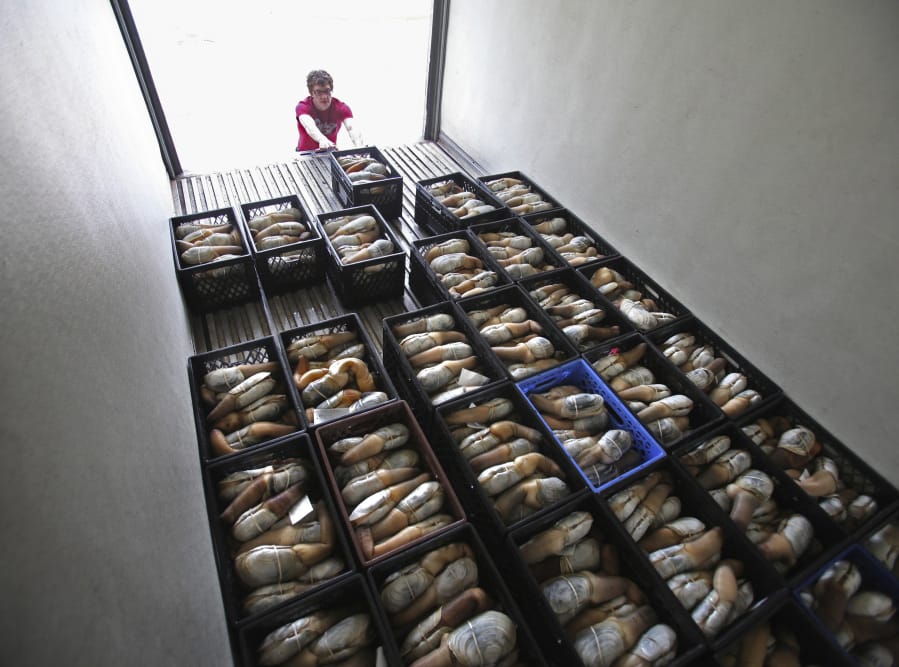ELD INLET, THURSTON COUNTY — Some 40 feet down, diver Walter Lorentz groped along the Puget Sound bottom, searching in the weak undersea light for small dimples that would mark the site of a buried geoduck. He wielded a “stinger” — a high-pressure water wand — to help pry these giant clams loose from the sand and cobble where they may have resided for decades.
This is a tough way to make a living, and on this gray fall morning was tougher still due to a small hole in his dry suit that let in a steady stream of chilly water.
“When you’re in this business, you basically work with what you got, and make it all happen,” said Lorentz, who harvested some 400 pounds of geoducks in about three hours.
By the next day, these geoducks — still alive — would be on sale in China. There, they are a costly delicacy viewed by some as an aphrodisiac and often served — simmered in a hot pot — at weddings, business banquets and high-end restaurants, where a two-pound geoduck may fetch more than $100.
For more than a decade, surging demand in China and high prices have fueled black market as well as legal harvests.
But this year, the Asian market has cooled, and U.S. producers are finding it’s more difficult to wrest big profits from the Chinese geoduck market. That also means a sharp cut in revenue for the state of Washington, which has earned millions of dollars annually by auctioning off geoduck harvest rights.
One reason for the downturn is a retaliatory tariff imposed by China reaching 35 percent last month, as part of the fallout from the trade war that has flared as President Donald Trump seeks to reshape the terms of commerce with America’s largest trading partner.
The geoducks, found in waters off the Northwest, British Columbia and Alaska, burrow up to three-feet deep into bottom sediments, where they are nourished by long gangly siphons that bring in seawater full of phytoplankton. Though they can live for more than a century, they can reach market size in a half-decade or less.
With the Chinese tariffs in place, Washington geoducks are at a competitive disadvantage with British Columbia geoducks exempt from the tariff. This has helped to knock down the prices that the buyers are willing to pay for the wild Washington geoducks, a harvest totaling some 5 million pounds annually which is jointly managed by the state Department of Natural Resources and Puget Sound tribes.
The state revenue from a series of geoduck auctions tallied nearly $28 million in 2017. Since the first phase of the tariff was imposed in the summer of 2018, the average price-per-pound of the winning bids has dropped by nearly 45 percent. The state’s geoduck revenues, which help finance salmon restoration, are expected to decline to less than $16.8 million in 2019.
“Basically, when the tariff goes up, we have to lower our purchase price to get the price the customer will still tolerate,” said Jason Li, co-owner of Kent-based Grayzone Seafood and Trade, the winning bidder on the state Department of Natural Resources tract that Lorentz helped harvest in Eld Inlet west of Olympia.
Tribes also have taken a hit from China’s tariffs.
“Geoduck was one of our main sources of revenue, and it’s definitely had a big impact,” said Andrew George, marketing manager for Suquamish Seafood Enterprises, which generates revenue to fund tribal programs.
Shift in economy
The tariffs do not appear to be the only reason that auction prices have plummeted.
Li said that Chinese demand for the clams has slackened as consumers have embraced other high-priced seafood delicacies such as Russian king crab. His typical daily sales, in recent months, have been about 1,000 pounds of geoduck a day — down from 2,000 pounds a few years back when the market was stronger.
Other geoduck producers cite a broader downturn in the Chinese economy that has dampened demand, as well as the protests in Hong Kong — a key market — that has reduced the number of people going out to eat at restaurants that might serve up the shellfish.
Chinese buyers also are pickier about what geoducks they buy. Li said the lower bids for the state’s geoduck also reflect concerns that underwater tracts off the Washington Coast have greater quantities of discolored clams with rough skin. Such clams may be older, or grown in rougher, rockier bottoms that can warp their body shape and result in thicker shells — and thus less meat per pound.
“This lower grade, it doesn’t pay enough (in China) to cover the tariff costs,” said Li, who said he tries to find U.S. markets for these clams.
Geoducks also are grown on shellfish farms on private tidelands that typically produce younger clams of more uniform quality. The price decline for those geoducks has been more modest — roughly a 25 percent dip since the tariffs were imposed, according to Jim Gibbons, president of Seattle Shellfish, a major state producer of farmed geoducks.
When Lorentz took his dive earlier this week, there appeared to be ample numbers of blemished geoducks, some with mottled scabby spots on their skin. These clams were stacked in a separate bin on the dive boat that served as his base.
Bill Norman, the skipper, said this tract had been harvested for several years, and the overall quality was on decline.
“If they want top-dollar bids, then they really need to start looking into opening up some new areas,” Norman said.
Blain Reeves, assistant aquatic resources manager for the Department of Natural Resources, said the wild geoduck harvests are managed on a sustainable basis, with the tribes and state selling only about 2.7 percent annually from the total Sound harvest areas.



